Mobile Trolley UV Sterilizer Disinfection Lamp Germicidal UV Sterilizing Light with Wheels

Power 100W or 150W is suitable for area of 40-150m2. It is specially used for large areas (schools, hospitals, factories, etc.)
Includes timer that can be set for 15, 30 or 60 minutes to allow exit from the room in order to avoid exposure to UV-C light.Automatically switches off when the desired time has expired.
10 secs activation delay,Long-distance remote control is more worry-free and can pass through walls
Reduces allergic reactions by eliminating airborne contaminants . Wheel design for easy movement
This product is divided into two types: UV and UV+Ozone. The model containing ozone needs to wait 40 minutes after use.
Usage Instruction:
1.Pls clean the room before using uv room sterilizer.
2.Carefully place the UV Room Sterilizer in the center of the room or on a spot where UV light can beam more things in the room.
3.Arrange everything found in the room to ensure they will be exposed to UV light. Place things that are touched more often closer to the system to maximize sterilization.
4.Plug in and set the timer to the desired duration.The system has a time delay of 15 seconds upon timer setting,this allows the system operator to vacate the room.
The UV light will be on after 15 seconds.Sterilization start .
(We suggest a minimum of 30 minutes to a 30 sq.m.areas.)
5.Medical Sterilization High Intensity UV lamp will suspend and uv light will shut off if someone is around the machine.Then resume when people left.
6."Lamp 1 "control 2 lamps,'lamp 2"control another 2 lamps.
7.It will generate smell after sterilization.It's perfectly natural.Pls open the window to let the smell out after sterilization.
8.Wipe the lamps with dry cloth after sterilization.Carefully stow the arms in the arms door.
Product Description:
UVC Light Sterilizer,has four (4) 30 watts germicidal ultraviolet
lamps that emit a high intensity ultraviolet light that hits every
surface in the room and kills any micro organisms or pathogen including
MRSA,hand foot mouth disease,colds and
flu,pneumonia,molds,e.coli,salmonella and similar type bacteria.
UVC Light Sterilizer is laboratory tested ,used by hospitals and recommended by doctors.
Top 2:FY® 30DC Mobile UV+Ozone Disinfection Car Ultraviolet Lamp Sterilizer Trolley Cart Unit Hospital

Products Description:
FY UV Room sterilizer FY-30DC,has two pcs of 30 watts UV lamps that emit a high intensity ultraviolet light that hits every surface in the room and kills any micro organisms or pathogen including MRSA,hand foot mouth disease,colds and flu, pneumonia,molds,e.coli,salmonella and similar type bacteria.
The light penetrates and destroys the actual DNA of micro organisms.
There is no known micro organism that is immune to UV-C energy.
UV Room Sterilizer disinfects approximately up to 30 square meters room area.
There are numerous safety features bulit with a 0-120mins timer.
UV Room Sterilizer has numerous applications not just for hospitals but can be used in schools,play areas,hotels,clinics,homes,cinemas,
buildings,food manufacturing companies and offices.
Top 3:
FY® 30FSI Mobile UV+Ozone Disinfection Cart Lamp Ultraviolet Sterilizer TrolleyWith Infrared Sensor

Product Description:
UVC Light Sterilizer Trolley,has four (4) 30 watts germicidal ultraviolet lamps that emit a high intensity ultraviolet light that hits every surface in the room and kills any micro organisms or pathogen including MRSA,hand foot mouth disease,colds and flu,pneumonia,molds,e.coli,salmonella and similar type bacteria.
UVC Light Sterilizer is laboratory tested ,used by hospitals and recommended by doctors.
Technical Specification:
1.Tube Power:30W
2.Number of tubes:Four(4)
3.Application area:60 m2
4.Voltage:220V±10%,Frequency: 50HZ±10%
5.Input power:180VA
6.UV Wavelength:253.7nm
7.UV illumination: ≥428uW/cm2
8.Can be operated with 2 or 4 lamps by pressing Lamp 1 or Lamp 2 button
9.Lamps have side compartments for safe storage
10.Angle of the lamp arms can be adjusted from 30-180°
11.Timer can be set to desired duration starting from 15mins to 1440mins
12.With infrared sensor function, if people or animals are accidentally break into during the disinfection process, the light will immediately give out the alarm and go off automatically. It will be on after they go away.
2020 Top 3 Brand Mobile UV Trolly Cart Unit You Should Know


